Today, when you walk around outside you see people with a hoodie, sweatpants, and some trainers, or even in the summer with a pair of shorts with flip-flops and a stained shirt. Modern style has gotten so casual overall, and we think vintage men dressed better. The good news is, you adapt and be inspired by their style without looking dated!
Whenever I look back at old films, magazines, or even family albums, one thing is painfully obvious: all these people look so elegant and they were dressed so well even though they might have just been a farmer, a store clerk, or just an everyday person going about their business.
So, how did Cary Grant, Sydney Poitier, William Powell, or even your grandpa manage to look so good? We try to answer this question by looking at ten different things vintage gentlemen did that many men today don’t anymore.
1. Black Tie
First, let’s kick it off with a very clear example, which is Black Tie. No matter whether it’s a vintage fashion plate, a painting, or James Bond in a movie, they all look so irresistibly dapper and handsome. That’s especially true when compared to what passes as black tie today at the Oscars, weddings, or gala events.
So, the big question is, what went wrong? Back in the day, chances were that, even as a middle-class person, you owned your garments and didn’t just rent them. Okay, maybe with the exception of the 60s and 70s when men started renting stuff. And looking back at those pictures, just think about those ruffled shirts and gigantic bow ties.
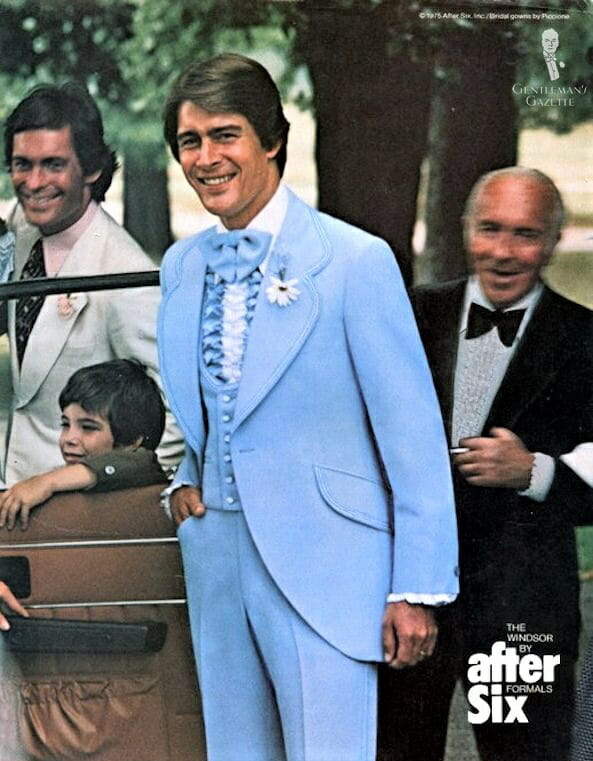
Yes, once men started renting tuxedos, things went downhill quickly. But, even just a few decades earlier, men did not rent. Even the blue-collar Popeye from 1956 owned a tuxedo. Because renting a tuxedo is so popular these days, we wanted to see what you actually get for your money, so we made a post about rental tuxedos, why we think they’re not worth it, and what you can buy instead.
By investing in a tuxedo, men could guarantee that they got something that actually worked for them and their body, that they were comfortable in, that they could wear, clean, and enjoy.
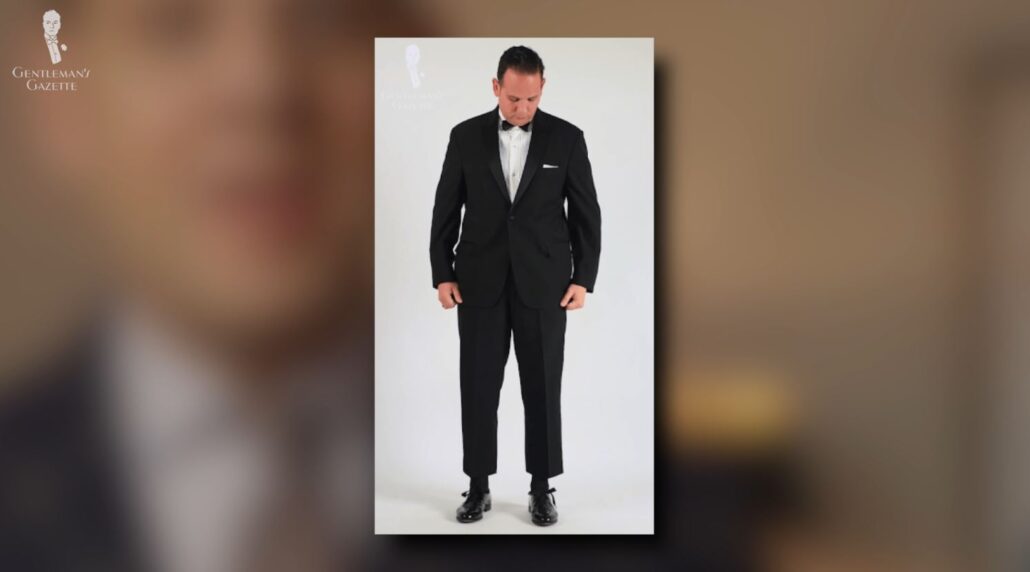
Realistically, men back then had to spend more of their income on clothes because the production had not been shipped offshore. Of course, more people wore tuxedos, which meant there was more variety in the styles that they could buy at a regular store and the accessories.
I mean, they had different bow tie shapes, different sizes, slim ones, big ones, pointed ones, and so forth. If you go to a store today, you’re lucky if they have a single kind of bow tie that you can actually tie yourself and that’s not pre-tied. Otherwise, you just look like a boy who goes to prom.
If you’ve never tied a bowtie before, no worries. We got you covered with guides for beginners that are easy and we have more advanced ones. We also offer a range of bow ties that are all self-tie in shapes that are guaranteed to work for your face shape.
Of course, it didn’t stop there. They had evening waistcoats or cummerbunds, boutonnieres, pocket squares, socks, evening shoelaces, and so forth. Sadly, today, most men lack the knowledge of Black Tie and what to put together.
Fortunately, we have the most comprehensive guide on that matter that tells you everything about the history, what you have to wear. And, even if you have just five minutes, take a look. We’ll walk you through what looks best on you and why you should wear it.
The Black Tie Guide
You might think, “Aren’t dress codes really a thing of the past? Aren’t we all ‘individual’ today?” Well, yes and no. Dress codes are the idea of helping you to put something on that was acceptable, so you could focus on the company rather than being self-conscious about your outfit and whether you’re over or underdressed or just dressed appropriately.
Back in the day, gentlemen had the option of White Tie, which was arguably the most elegant thing for them to wear and, looking at that, it is really stunning. Every man I’ve ever seen wearing a White Tie tailcoat just looks awesome.
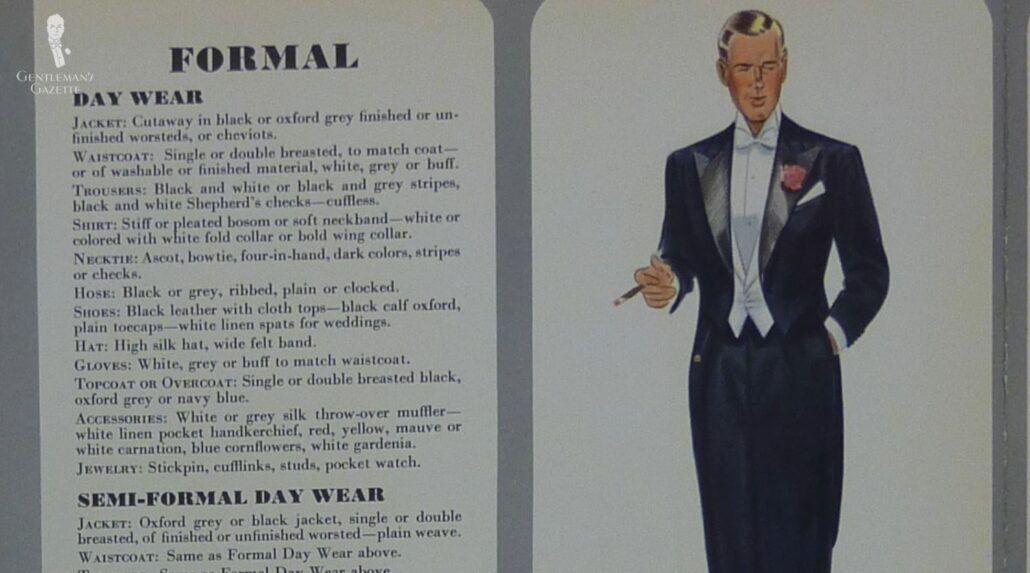
Why is that? Well, the dress code is very strict and there’s not much room for individuality, other than maybe the bow tie shape or the color of your pocket square. Black Tie, on the other hand, gives you a little more variety in terms of the color, maybe a midnight blue or something in a really dark navy with black silk lapels. Maybe you want different slippers in velvet or on the bow tie front. But, after all, it’s still rather limiting but, because of that, it’s much easier to look dapper and handsome.
2. Shoes
The second thing vintage men wore better were shoes. We already discussed in a different post why men stopped wearing dress shoes, but, back then, obviously, they did and dress shoes not only had an elegant last, but they were also made of higher quality materials than sneakers today.
That, of course, was reflected in the price. Again, shoes weren’t made offshore and a nice pair of Florsheim in the 1940s cost you $10. Considering that the annual family income was $1,600, that’s the equivalent of a pair of Florsheim and today that costs $400.
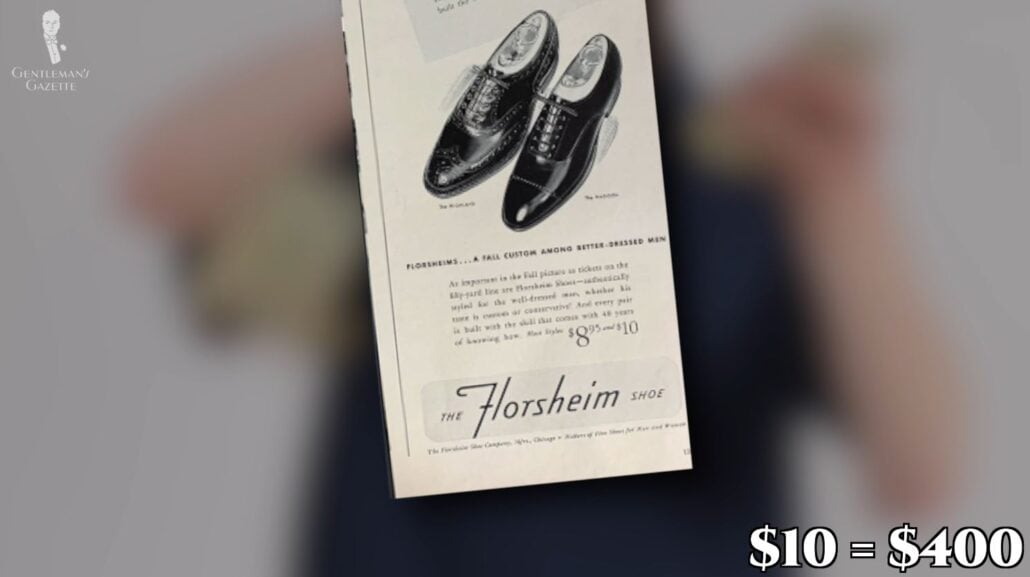
Florsheim, of course, you can get for a lot less and we made a guide on the difference between $100 and $500 shoes, where the Florsheim only cost a hundred. But, if you get a pair of $400 shoes today, you get what most men wore back in the day. Now, if you ask any man in the street how much they spend on their shoes, the average will definitely not be $400.
At the end of the day, if you look back, vintage gentlemen were forced to buy more expensive shoes. But, they also lasted longer and the cost per wear was low.
Today, we’re constantly tempted to buy that next pair of low-quality shoes because it’s in line with the latest trends. But, it leaves us unsatisfied and with something that we have to throw away, that can’t really be repaired.
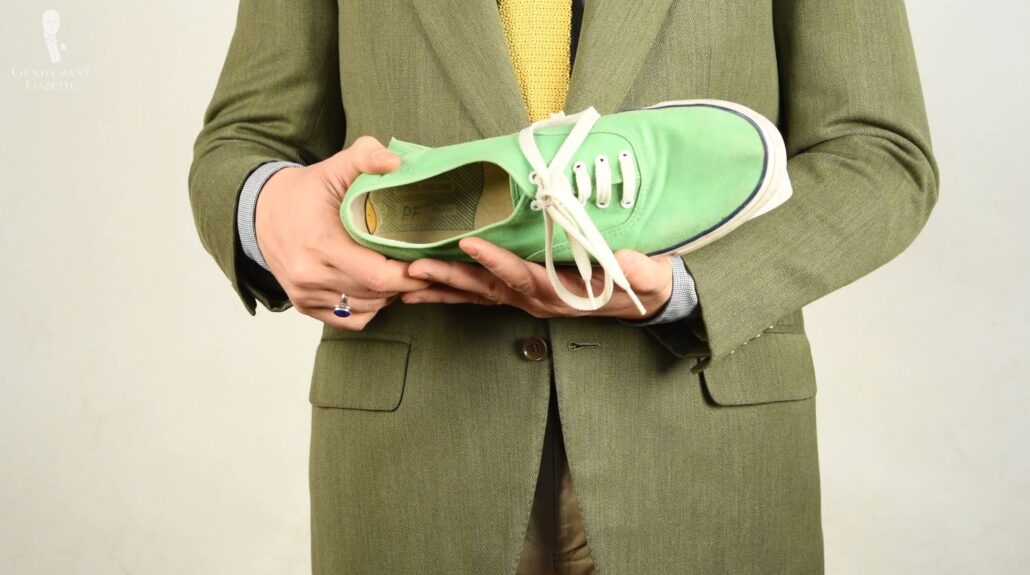
You might say, “If I have to pay $400 for a quality pair of shoes, I can only afford to have one or two pairs and that’s not enough for my style. It’s not varied enough.” Well, in that case, it’s great to start out that way and, if you want a different look, you can get different colored shoelaces, which really change the game.
A black pair of Oxfords may be perfect for an interview at a bank, but with a red pair of shoelaces, it makes all the difference. And now, you can go to a cocktail party and look dressed to the tee.
Of course, back then, men didn’t have the chance to order online and, even though Sears was around, they would typically buy their shoes at the store. They also had more widths and shoe lasts that allowed for a more comfortable fit.
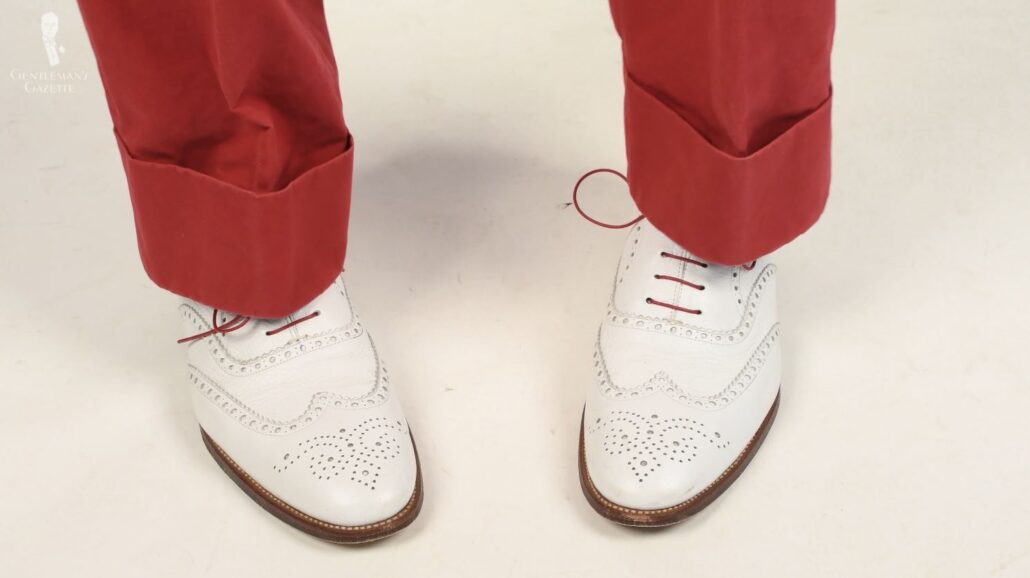
Shoes were also made so that they could be repaired by the local cobbler. Try that with your Nike sneakers. And also because vintage men had to spend so much money, they took care of their stuff. They polished them, moisturized them, put their shoes in shoe trees, and had a few quality items in their wardrobe.
Well, today, most men don’t wear shoe trees. They don’t care about their stuff. When a sole is worn down, they’ll just toss it and buy a new pair because the repair locally for a pair of shoes that cost $70, $80, or $100 would probably cost about the same as a pair of new shoes made abroad. Some Americans back then were so proud, they told their mothers about their new shoe purchases.
3. Socks
The third thing vintage men look better in was generally their socks. You might think, “Well, they had navy socks and black socks and maybe gray socks.” But, that couldn’t be further from the truth. They actually had socks in a variety of colors and patterns, sometimes with hand-embroidered clocks.
Trying to buy or sell something like that today would cost you a small fortune. Most of them back then were over-the-calf socks that stayed up or they had sock suspenders for their shorter socks. So, the look of the sock was never crumpled up, but always smooth between the shoe and the hem of the pants.
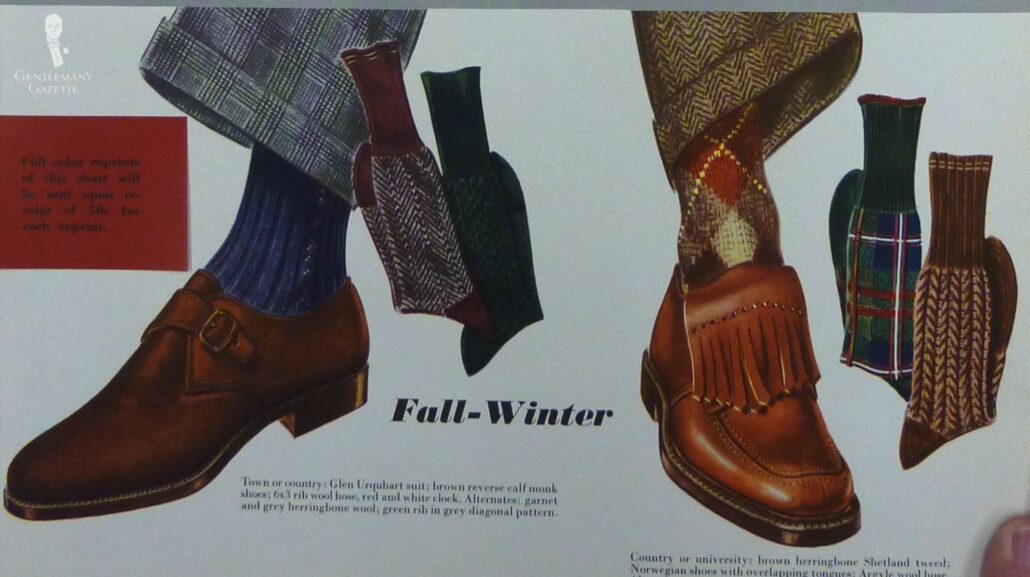
If you buy a $4 pair of socks today, they’re gonna be thicker, they’ll have more synthetic materials, which makes your sock warmer than all-natural materials that were worn back then, and, overall, not as sophisticated looking as with a higher-quality pair of socks made of natural materials.
$4 vs. $40 Socks: Which is the Better Value?
Look at old advertisements or fashion magazines. It is stunning how much the market for socks has changed today. If you go to a regular department store or even haberdashery, often the selection is rather limited and dim. Of course, there are many men who like to buy their socks in a multi-pack on Amazon or at Costco. But, as the Hanes ad describes, “buy cheap socks and you’ll pay through the toes.” Ironically, Hanes today is not what I would describe as a quality sock anymore.
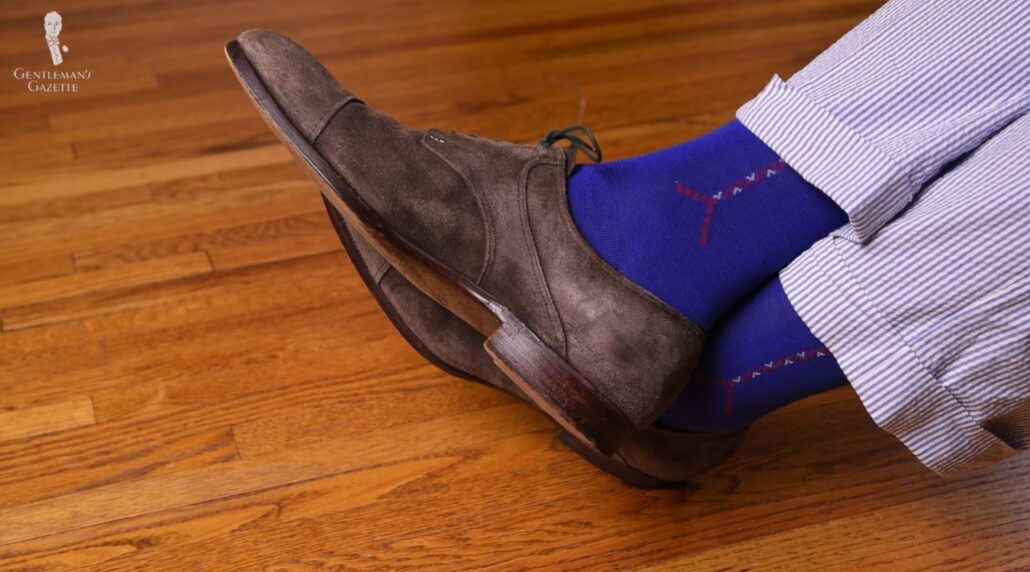
I mean, I get it. Some men may be intimidated by all the different sock colors and the patterns and how you can combine them, but we got you covered. We have a guide on how to pair socks with shoes that shows you how you can elevate your outfits with a simple thing such as socks.
4. Trousers
The fourth thing vintage men were better than men today are trousers, slacks, pants, or whatever you want to call them. So, again, the question is: why did they look so good? In my opinion, it’s because they all had high-rise trousers.
This means that your pants actually sit on your natural waist around your belly button, not just on your hips. Not only did that make your pants more comfortable, but it also elongated your leg line and made you just look better.
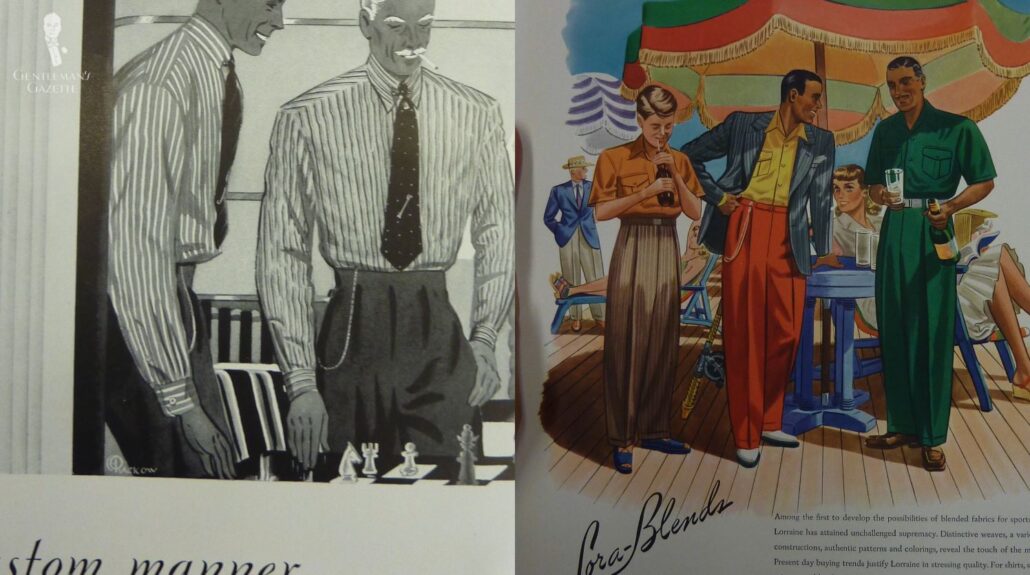
Some may argue it had to do with the fullness of the trousers but, if you look at the 1910s or 1920s, pants were slim, maybe similarly slim to today with a slim hem. By the 1930s, everything got a lot bigger and fuller. But, what all of those decades had in common were high-rise trousers that sat at a natural waist. No matter how full or pleated the pants were.
Then, of course, the pants fit the people who are wearing them. They weren’t super tight and they weren’t gigantic either. I mean, just look at me and my thigh. I have these big thighs, so I generally can’t wear off-the-rack, flat-front pants because they always make me look like a pressed sausage. Because of that, I typically wear pleats or I have to go custom to get a pair of flat-fronted pants.
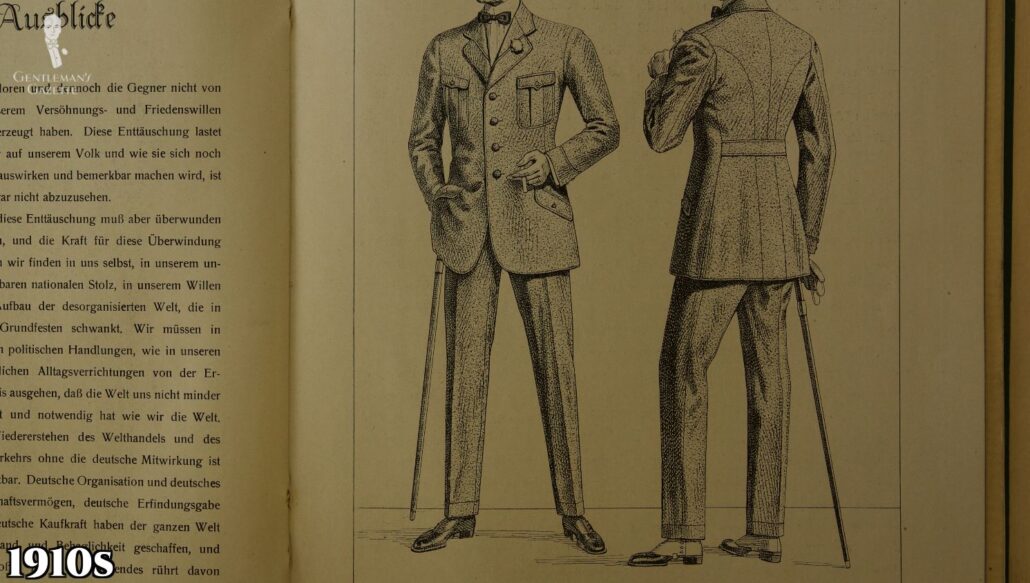
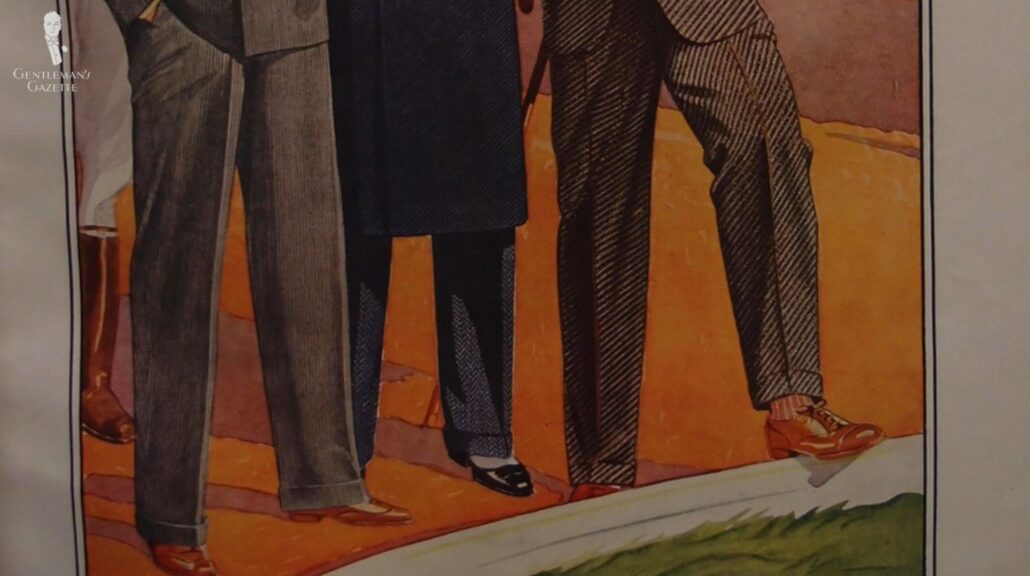
Another reason why men back then looked better is that they either wore suspenders or belts. Suspenders have the advantage that your pants rest on your shoulders, so you can actually have a little more room in the waist for a big dinner or lunch. But, throughout the day, they will always hang at the exactly same height, which allows for more comfort.
Belts, which became much more popular in the 30s and in the following decades, can also help you keep your pants up, but it’s much easier if you have that high waistline because it just grips your body better than just over the hips.
How Should Pants Fit?
Of course, it helped men back then that fashions weren’t as short-lived as they are today and they also weren’t as extreme. I’ve never seen skinny jeans, for example, back then.
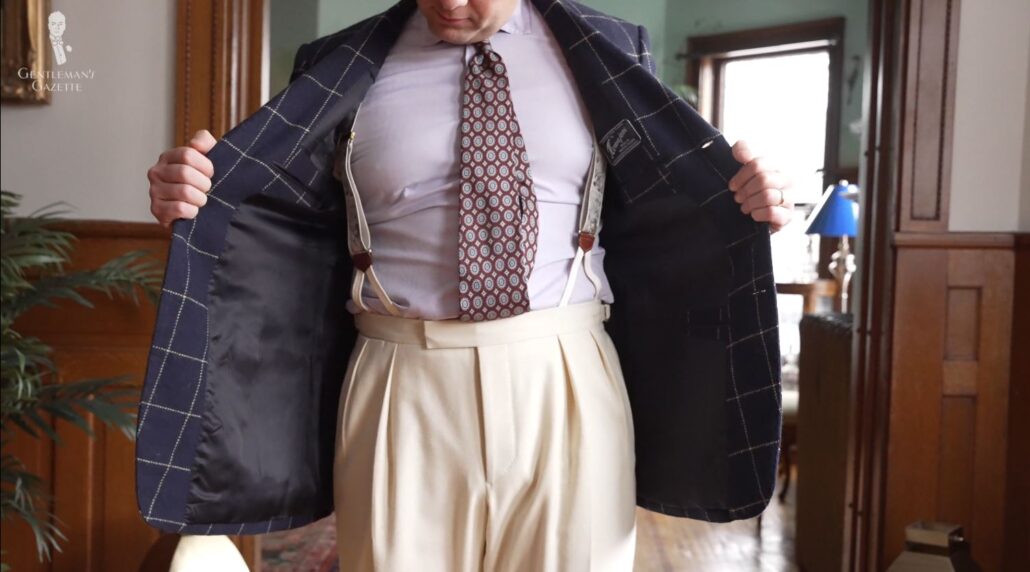
That being said, the 1970s bell or hyper flare jeans that looked like Oxford bags became a trend. In all honesty, though, I’ve never seen someone wearing something like this on the street. However, I’ve seen plenty of skinny jeans. Another god-awful trend is tactical cargo pants.
So, if you want to look your best in pants today, take a page from history. One, get a pair of high-rise trousers; two, make sure they work for your body type; and three, go to the alterations tailor and make sure pants have enough of a fabric reserve to let them out in case you gain a few pounds or other things happen.
It’s always easier to take pants in than to let them out, but you also can’t take a pair of pants that is three sizes too large and make it fit. It will just look awkward, and your pants and your pockets will be in the wrong spot.
5. Dress Shirts
Another thing vintage men wore better were dress shirts. If you look around today, most men wear shirts in either a solid white or blue for business wear. For casualwear, sometimes you see these bright tones of turquoise or red or all black is also very popular or maybe denim shirts. No, we don’t have anything against denim shirts, but they have their time and place.
If you take a closer look at the dress shirts that were available to men back then, you’ll probably be surprised. They weren’t all just white and light blue, but there were lots of subtle tones, such as pastel, green, yellow, peach, lavender, orange, and so forth.
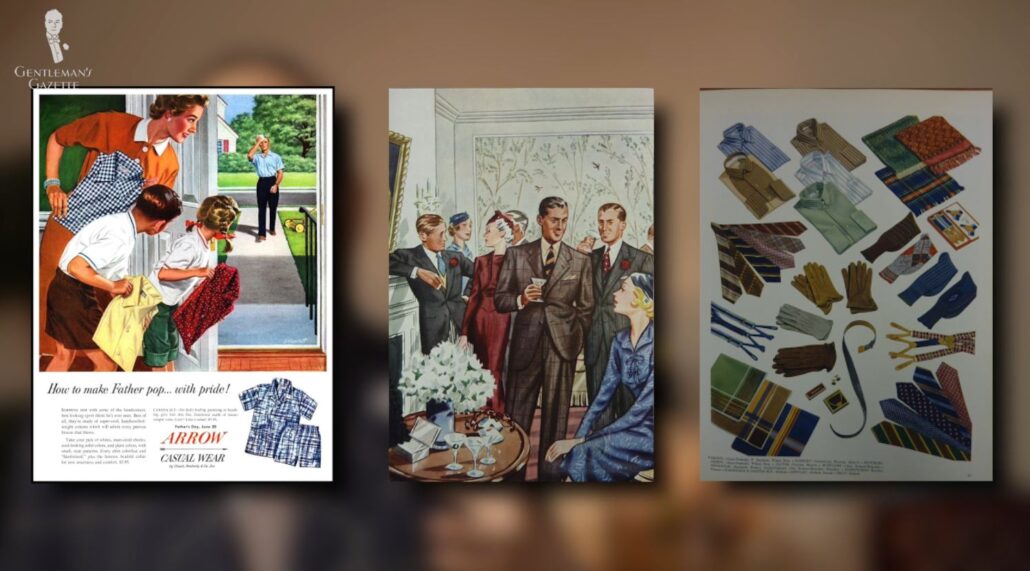
Moreover, they had a lot more patterns, subtle micro patterns, checks, maybe little houndstooth ones, or interesting stripes. And sometimes, there was just a subtle contrast so from afar it would look like a solid but, from up close, it revealed to be more interesting.
Even though many off-the-rack vendors don’t sell shirts in a bright color palette, fortunately, we now have lots of custom offerings on the market. So, you can make sure your shirt wardrobe is more varied and not just blue and white.
So, what’s the ideal shirt selection for you? It depends on your lifestyle, your climate, and your taste. We created a guide telling you what shirts you really need and try to guide you in the right direction, so you end up with something that works for you. And no, it’s not just about the color and the pattern, but also about the collar shape.
Back then, companies like Arrow educated men and explained to them what type of collar would work well with their face. For example, if you have a big, round face, having a small collar will look odd or, if you’re very small head with a big collar, that’s also off. Why? Well, a collar can accentuate your features or level it out. To learn more about what collar shapes work best for you, we got you covered as well.
Shirt Collar Styles for Men: A Complete Guide – Point, Spread, Cutaway & More
6. Odd Combinations
Another reason vintage men looked good was that they knew how to put together odd combinations. Today, it seems, if you look at the Oscars or at big events, monochromatic outfits are often popular because that’s probably what their style advisor told them to wear.
Keep in mind, back then, everything was more expensive, so men could only buy fewer items. If they wanted a different look, they had to maybe take parts of one suit and combine it with another, thus leading to all sorts of interesting combinations.
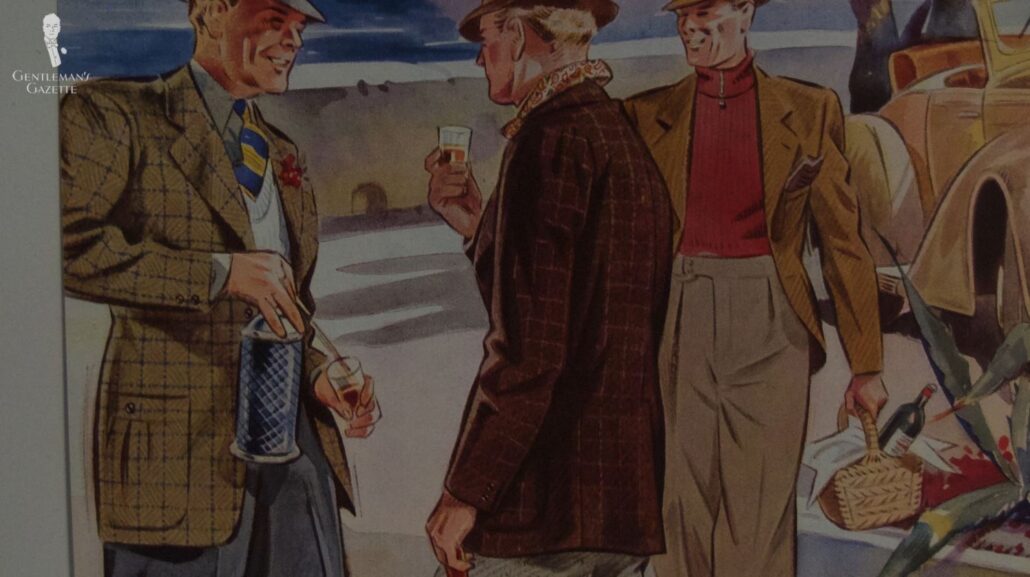
For me, it’s a pure joy to look at the old-fashioned illustrations, looking at different textures, colors, patterns, and styles men would wear back then and layer up. It has depth and interest, and it’s definitely an expression of their personality.
If you’re interested to learn from those vintage illustrations, we created an eBook that does just that. You can really tell men didn’t just take the easy way out and wear a pair of chinos in a solid tone with a solid polo shirt all day. They put a little more effort into it and it paid off.
7. Neckwear
The other thing men did back then was to actually have neckwear. They never had a practical purpose or hardly ever did. It was always decorative. Back then, men just accepted it as part of the general dress code. Today, most men associate wearing a necktie with discomfort.
I mean, back then, men even wore ties when they played tennis. Can you imagine that? Yes, there were lots of neckwear options. They had wools, silks, cottons, and later, rayon and nylon as those fibers became more popular.
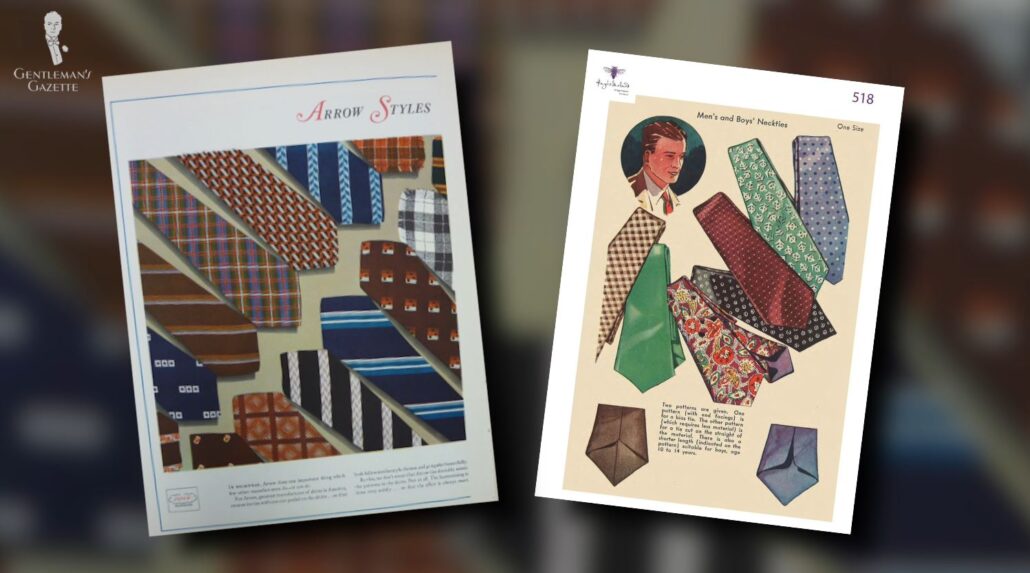
But, overall, the average man couldn’t afford to have hundreds of ties in their closet, so it was important to have something that was versatile for them. They had ties for work, ties for play, and then, of course, bowties, evening ties, and whatever they needed.
Interestingly, when going through old photos and illustrations, you never see men wearing bright, boldly colored ties in pink, green, or any other colors. Today, if you look at TV hosts, for example, they always have bright orange, yellow, and red ties that really stand out. It’s almost too much contrast and, sometimes, just glaringly bright.
Even if you compare vintage tie wearers to modern wearers, you’ll notice a difference, and it is the size of the knot. Today’s ties are often very thick and it’s not the fabric that’s thicker necessarily, but the interlining between the fabric.
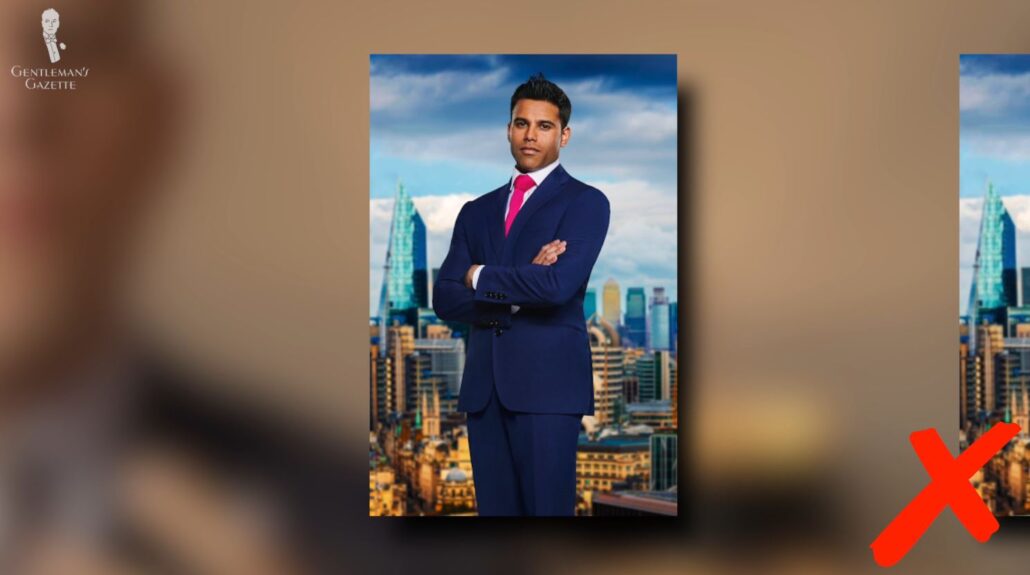
So, if you tie a knot today with a regular tie, the smallest knot is an Oriental knot or a Four-in-Hand knot and, even then, the knot is quite big. Back in the day, the interlining was thinner. If you wanted a thinner knot with your collar or if that was your style, you could get that result. If you wanted a bigger knot, then you went with a Double Windsor or a Balthus for example.
Looking back for some vintage ties, there were plenty of ugly ties. Not everything from the 30s through the 70s was great, but I think men had a better understanding of choosing the right tie for the rest of their wardrobe and their face and collar shapes.
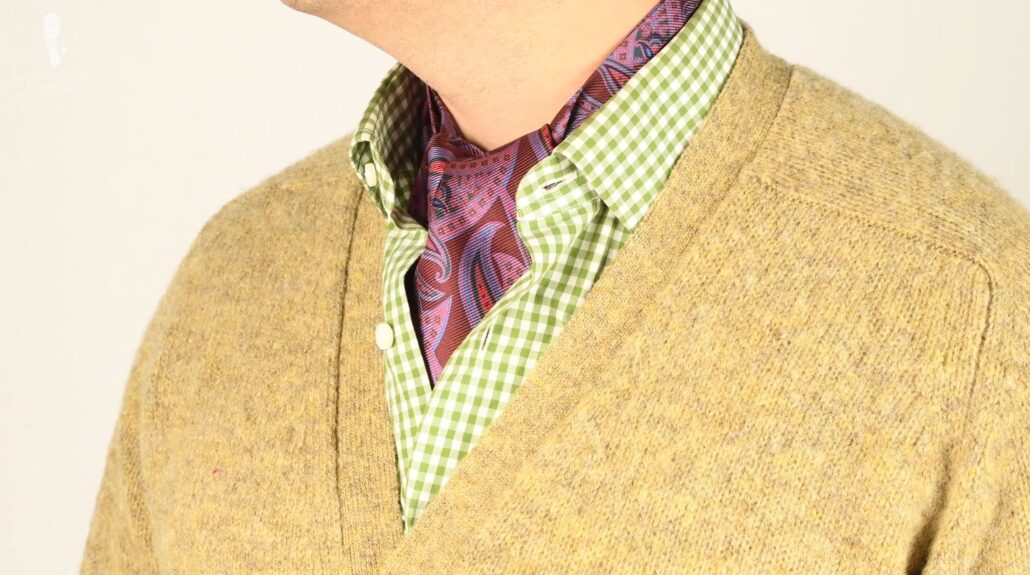
It wasn’t just about ties, though. Men also wore scarves or mufflers that were decorative or maybe a handkerchief or an ascot. I mean, just think about the last time you saw a man wearing a neckerchief on the street. I can’t. Maybe, sometimes, you’ll see someone that wears an ascot, but even that happens only once every blue moon.
However, the men who wear an ascot today definitely stand out and people notice right away. Why? Well, it’s unusual and, if someone wears an ascot, chances are they do so with confidence and it automatically gives them an aura that other people don’t have.
If you’re interested in upping your neckwear game, we have many tutorials ranging from How to Tie an Ascot to 12 Essential Ties Every Man Should Have.
8. Hats
Of course, one of the most obvious reasons vintage men looked better is that they wore hats. Today, most men don’t wear a formal, brimmed hat anymore. They may wear a baseball cap or a beanie when it’s cold outside, but not a bowler hat or a fedora or a homburg hat.
Why did men stop wearing hats? We got a post dedicated just to that question.
Why Did Men Stop Wearing Hats?
If men today decide to wear a hat, oftentimes, they don’t quite look like Humphrey Bogart wearing a fedora. Why is that? Well, it starts with the fact that, back then, there was a culture of hat wearing and people learned what to wear and what not to wear based on how they looked.
Today, rules of hat wearing are either unknown to people or maybe ignored. On one hand, a hat can be a great personal style hallmark, but it can also be a detriment if worn incorrectly. Finding a hat that works for you is related to your body type and face shape.
9. Overcoats
Yet another thing vintage men wore much better than modern ones are overcoats or outerwear. A very popular jacket these days for cold winters is a Canada Goose down jacket. But, in fact, it’s not nearly as warm as my heavy overcoats, which were made from heavy, durable wool.
If you buy an overcoat today and it says it is heavy, it usually means about 18 or 19 ounces in weight. Back then, they were like 30, 36 ounces in weight. So, almost double.
Yes, we’re dealing with climate change, but there’s plenty of places where it still gets really, really cold outside. And a heavy overcoat material doesn’t just keep you warmer, it also drapes better and looks better and that’s the reason they just look better when they wear an overcoat than when we wear a down jacket today.
Because more people wore overcoats back then, there was a greater variety. There were daywear varieties, there were formal or less formal, and there were evening overcoats. Trying to find an evening overcoat today is really difficult. Even tailors may not know what to make for you because none of their other customers ever request such a garment from them.
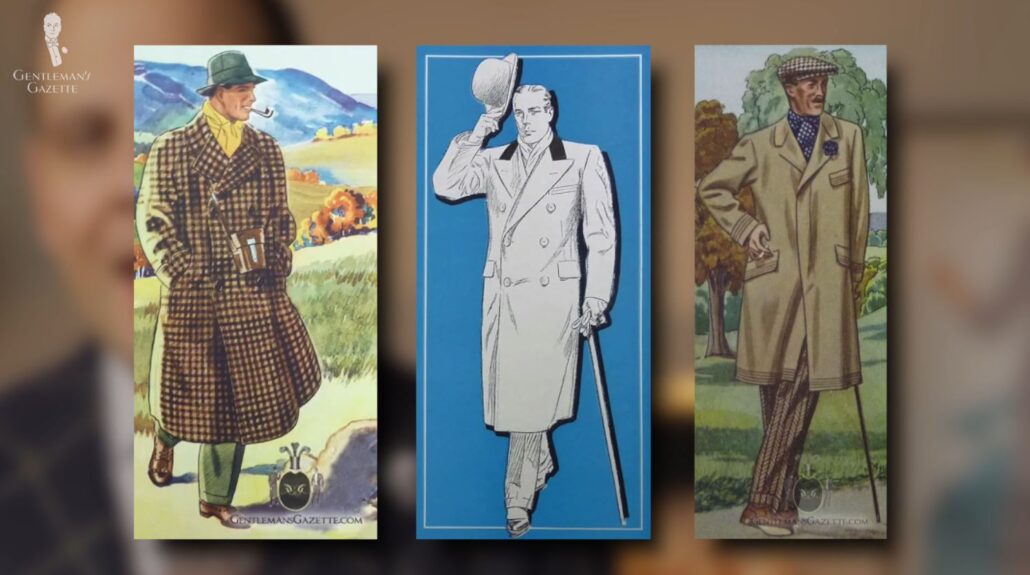
Also, the fabrics spectrum often was made from yarn with multiple colors in them that allowed you to combine it with various different colored items, but it always seemed to work. Overcoats today are often black, charcoal, or navy – all solid. That’s it.
I know today, sometimes, you can find overcoats with zippers and hoods. But, if you just look at the classic varieties, such as an ulster, a paletot, and a covered coat and there are many others, you will look dapper.
10. Pajamas
Last but not least, I think vintage men wore pajamas, sleepwear, and robes much better than modern men. I mean, today, people wear a hoodie and sweatpants at home. Back then, they had these really cool-looking pajamas in bold patterns or maybe a dressing gown or a nice robe with some Albert slippers.
Were they comfortable? Absolutely. Were they warm and cozy? Yes. It just looked so much better than sweatpants. I know you could say, “Well, no one will ever see me in my sleepwear.” You may be right, but it’s a general mindset and I think, if you take care of yourself and invest in yourself, you’ll show up differently, even when people can’t see you.
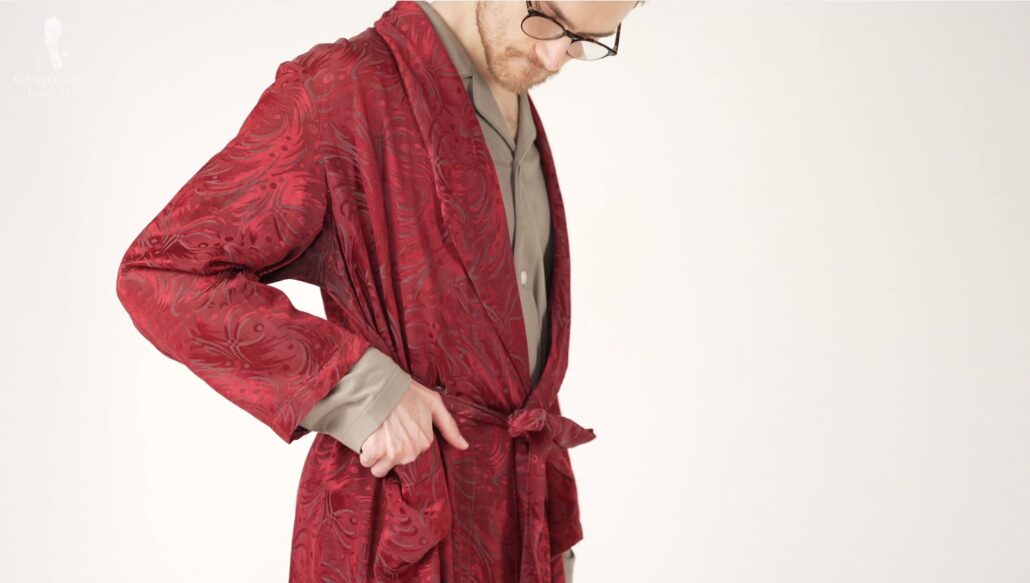
When I browse through old-fashioned magazines, I notice there are quite a few ads for sleepwear, slippers, and garments of that kind. Now, you think about it, if you spend about a third of your life or more in bed or in your bedroom, you might as well invest in that type of clothing.
When you watch old films or even a moderate period drama, like Downton Abbey, you’ll see that people just looked better in their sleepwear. I mean, just imagine if Lord Grantham would have worn a pair of underwear with a T-shirt. It wouldn’t look nearly as good.
Discover the Best-Dressed Decades in Menswear
BONUS: Watches
I think men wore watches better back then. Typically, they were smaller. They weren’t just all metal and flashy and bling. They also often wore more dress watches. So, men knew they needed different items for different occasions. Whereas, today, I think men often wear their Rolex, no matter if they show up for Black Tie or if they’re in their flip-flops on the beach.
For every occasion, there was a different watch, and vintage men used to treat a watch like an heirloom that was passed down in their family for years to come. It was less of a status symbol that it is today.
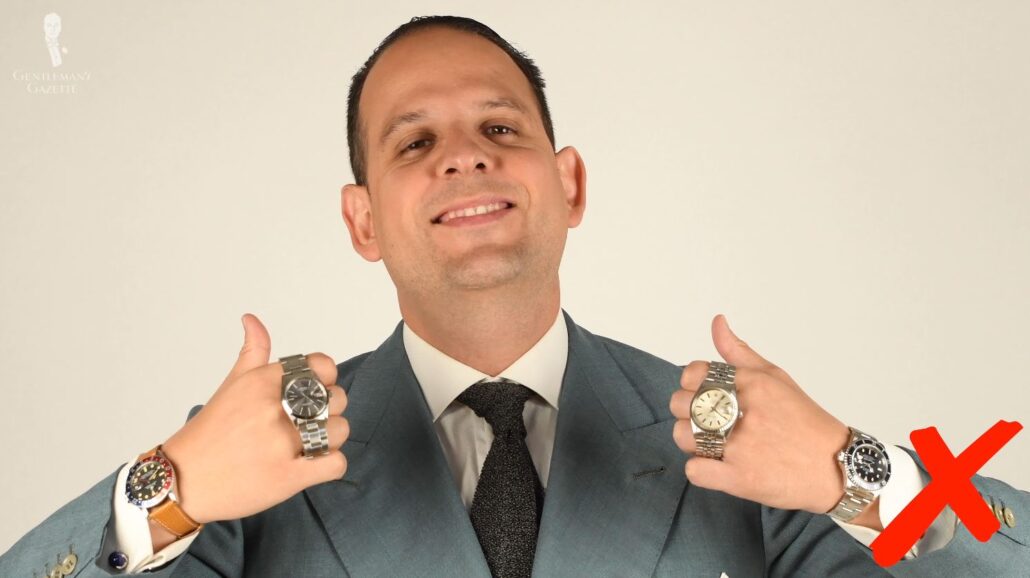
Frankly, I believe that many men today try to use a watch to flex or to use it as a status symbol, rather than as something that is part of their entire outfit.
Learn the 10 Commandments of Classic Style
Conclusion
Hopefully, we’ve shown you that the style of the past isn’t gone forever and it can be yours with a bit of effort, creativity, and know-how.
Outfit Rundown
My outfit today isn’t truly vintage. I think the tie is vintage, but it’s not 100 years old or anything like that.
The jacket was thrifted, custom-made one. It has this nice windowpane on dark blue. It’s a little more casual because it has lighter-colored buttons and elbow patches.
I definitely went for a 1930s-ish look with a pair of off-white flannel trousers with a fishtail back and suspenders. These suspenders are a bit whimsical and feature dogs. But, they’re interesting because, in the back, they have leather tabs. In the front, woven ones in brown and white, which are continued to my shoes, which are Allen Edmonds spectators, the model Bel Air in brown and white.
My socks are two-tone socks. They’re solid in like white and navy, so it picks up the color of the blazer, bringing in contrast between the shoes and the pants, and thus, tying the outfit together.
Want to stop dressing like everyone else?
My shirt is a pastel lavender one as men would wear in decades gone by. From afar, it looks like a solid, but it has a subtle herringbone pattern.
I’m combining it with a vintage motif tie and a boutonniere, which also picks up the tone of the shirt. I skipped the pocket square because I felt like, between a windowpane pattern, the flower, and the tie, I already had enough going on.
The cufflinks are a pair of vintage, enamel cufflinks that are lighter in color and, even though there is no yellow in other parts of the outfit, it’s very close to the color of the windowpane.
Which of these items do you wear like vintage men today? Let us know your vintage style techniques in the comments!
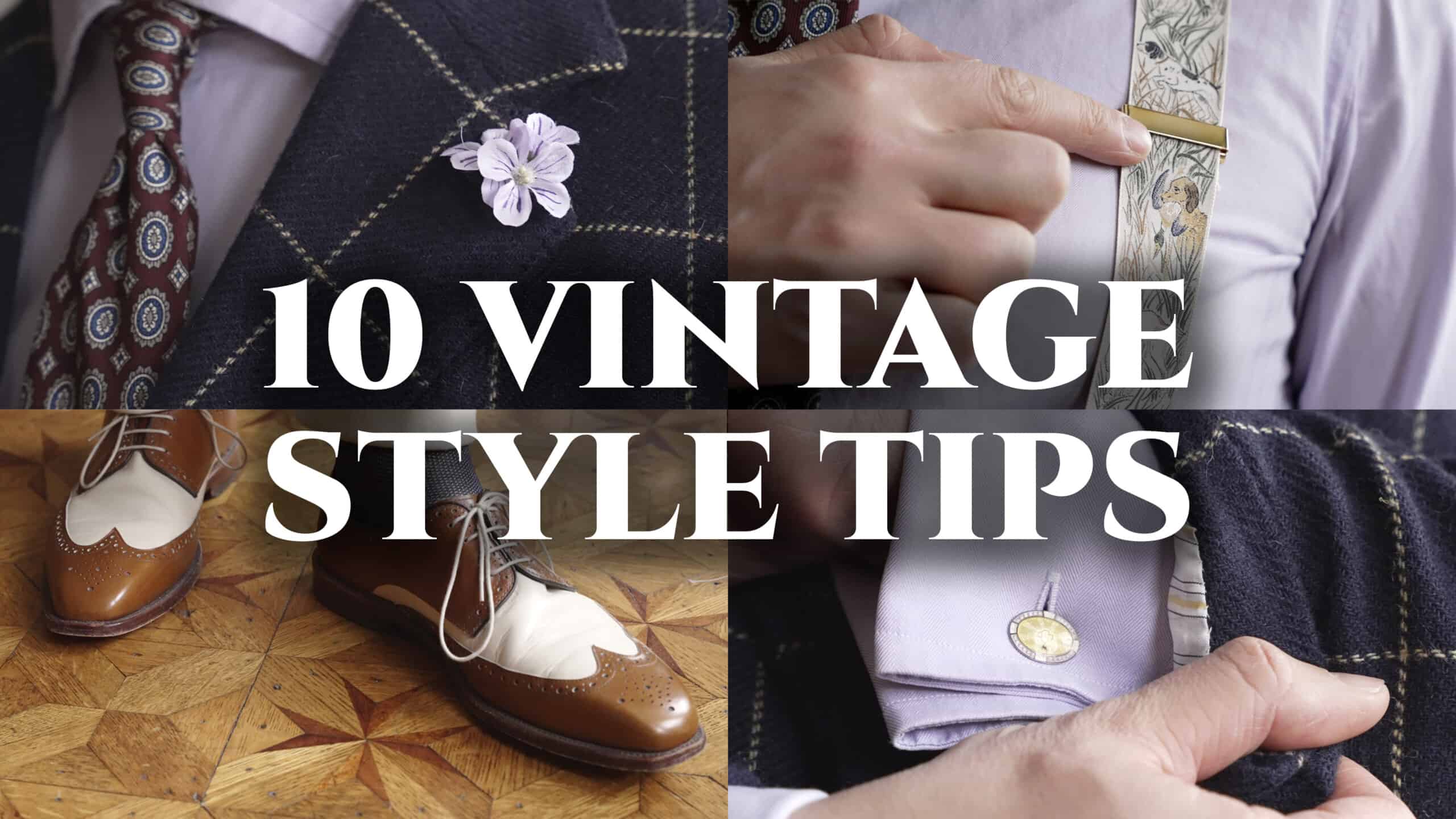

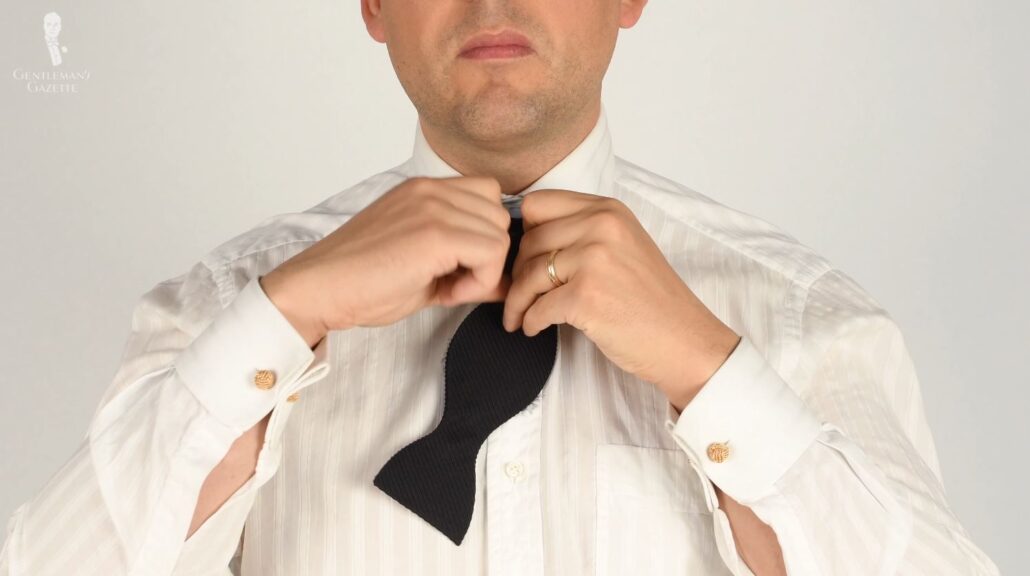
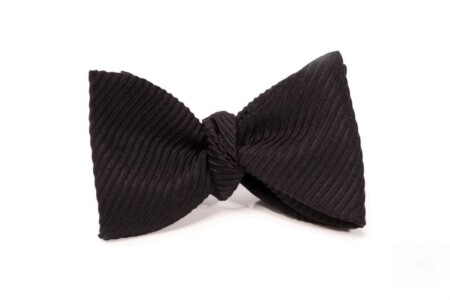
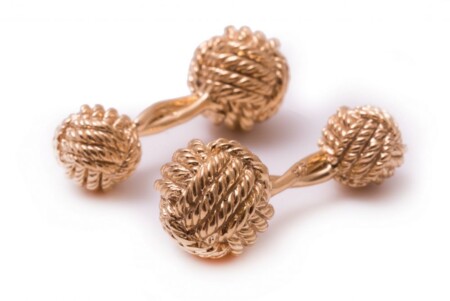
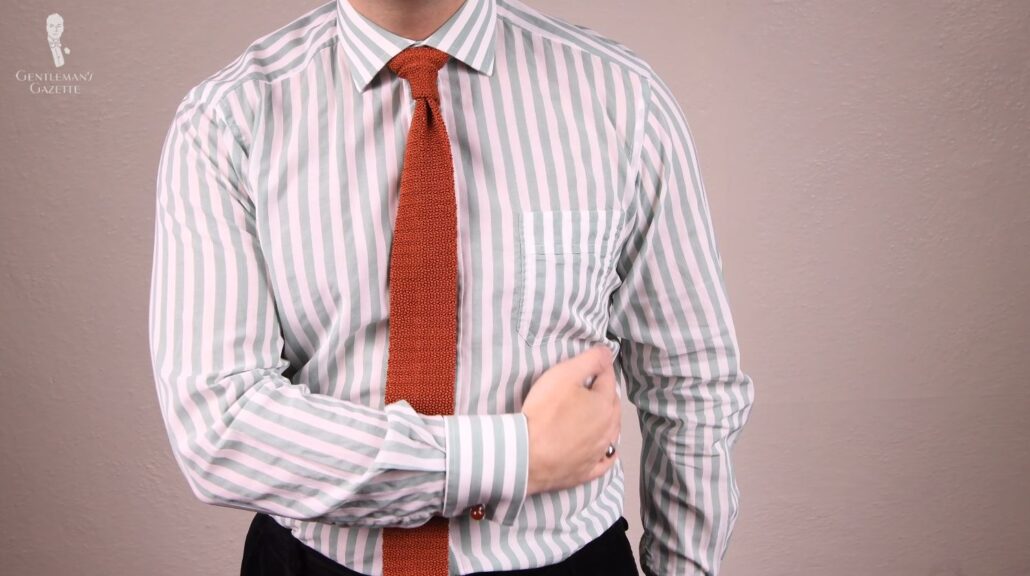
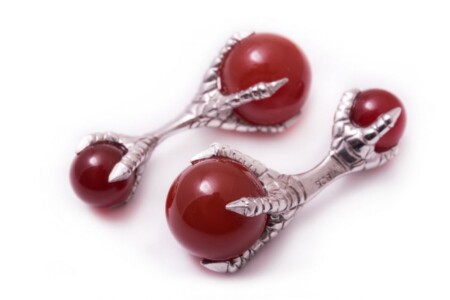
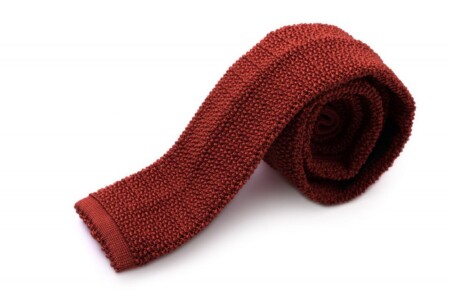

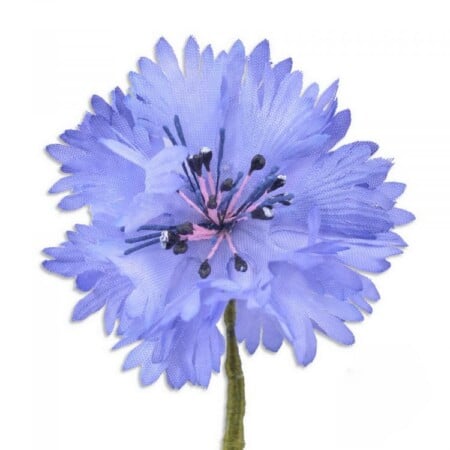
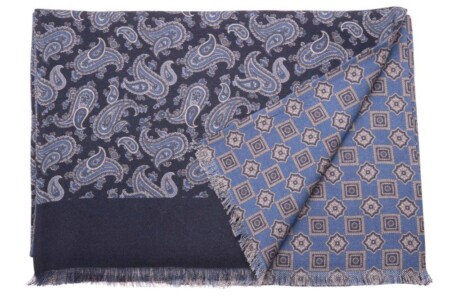
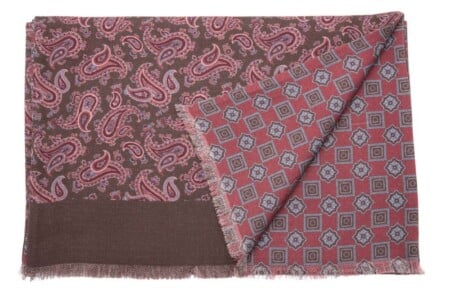
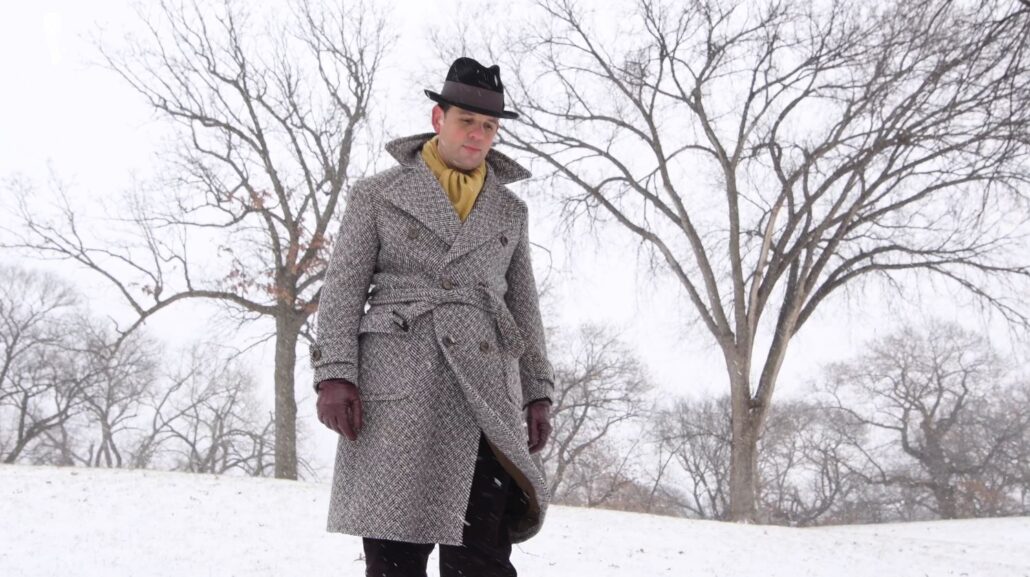
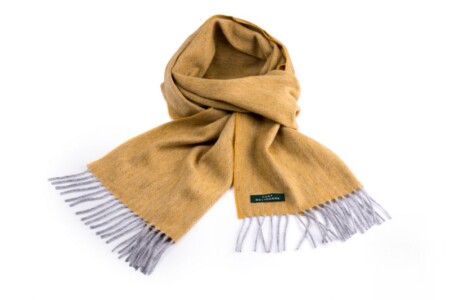
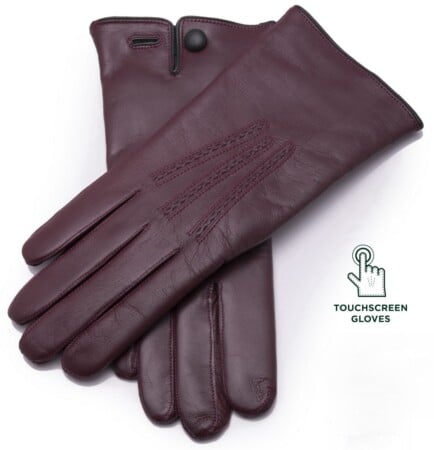
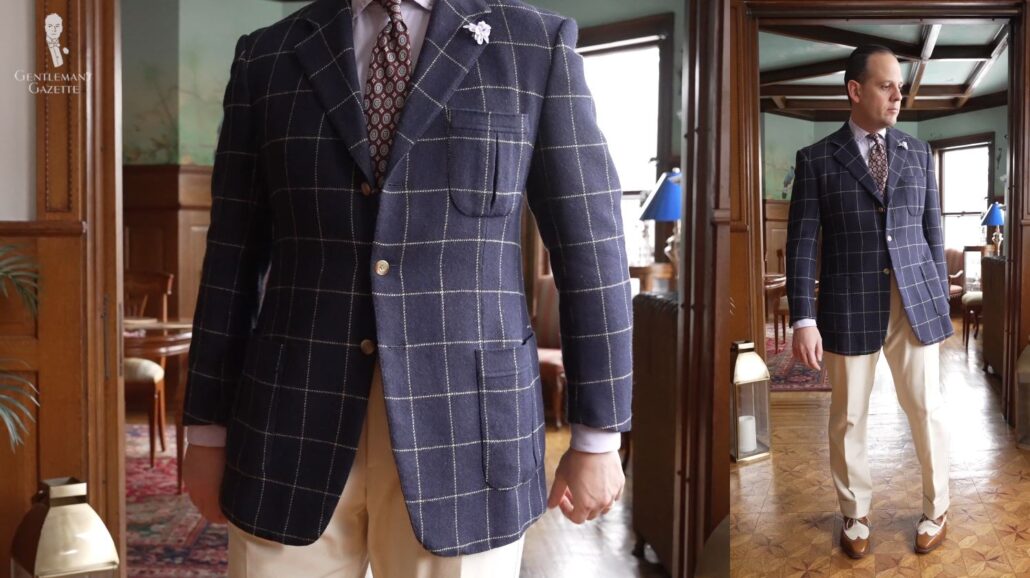
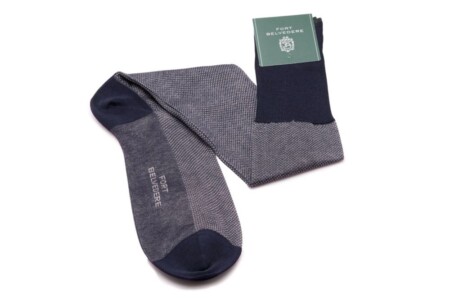
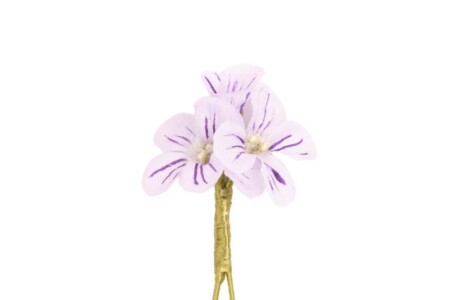
Great post, Raphael!
I think the another reason people do not wear trousers at the waist is because of the way waistlines have expanded over the last 30 years or so. Even having a larger waist, though, you will look better in trousers worn at the natural waist, and falling in a clean line to your shoes. This actually has a slimming effect.
Few things look worse than large midsections hanging over trousers worn on the hips, or tight clothes of overweight people. Look at all the size 6 and above women who stuff themselves into skinny jeans or worse, leggings.
Even when larger people wear looser or baggy clothes they often have a tendency to look sloppy rather than ‘large and in charge.’ I went to dinner at a local pub recently with relatives and was appalled to see some of the disreputable clothing choices. The one that took the cake, though, was a man in baggy sweatpants with his naked gut hanging over the waist (possibly his pants were too low slung but I wasn’t looking too closely), a stained t-shirt and flip flops.
My Dear Sir,
Nicely done! It’s not easy to continually approach men’s clothes from a variety of points of view each week. Your articles show creativity in themselves; looking at one’s wardrobe and asking yourself, ‘why do I wear it this way and not that?’ Or, ‘why did previous generations wear these particular clothes a particular way?’
Keep up the good work; I enjoy your commentary. And whether or not other gentlemen agree with your views, you certainly understand that you are causing them to also stop and ask themselves why they wear what they wear.
Best Wishes,
Have to hand it to you and Preston…you two can actually pull off wearing a derby without looking “costumey”.
No mean feat!
Wow. From head to toe we’ve become tacky. I remember my first trip to Vegas. Where it was all sport coats and a few dinner jackets, yes it was a long time ago. Now it’s T-shirts with rude slogans, cargo shorts and a pair of Croc’s. It seems to follow the general coarsening of our culture. I could go on but I won’t. I’ve reembraced Western culture, pleated pant, and fedoras again. Great article. Keep up the good work.
Yes, customers and staff alike have become tacky.
Recently I dined out at a Japanese restaurant where waiters dress in kimono style shirts. More than 90% of staff had sweatpants or gym shorts on the bottom with big clunky sneakers. As in sports shoes. I get they need shoes with cushioning and support because they’re on their feet the whole time. Yet with all the other options out there, including more discreet leather sneakers, I can’t understand looking that sloppy. When I worked in customer service showing our hairy legs (or even shaved legs) was a huge no-go.
Not that the customers were dressed any better. More than 80% wore shorts, t-shirts, sweatpants or ripped skinny jeans.
Scott,
So true. Our last few trips we’ve found ourselves actively “seeking out a Rat Pack experience” vice the usual riff-raff/pedestrian ones. Sadly LV now charges for everything so even those in incredibly crass t-shirts are getting soaked just as if they were high rollers. I’m guardedly hopeful once the casual crowd comes to that realization; “peak casual” will begin to make less and less sense. I mean if you’re dropping a grand a night anyway..?
I know the Slobocracy movement was starting long before COVID but I’m going to throw this one out there: is it just me or does anyone else feel like COVID has played a role in this growing culture of anything goes with all things sartorial? I’ve been reading comments for the last few years and seen a few from other fellow subscribers along the lines of how certain clubs they belong to will refuse entry based on attire (mostly those not dressed in jacket and tie.) Admittedly I’ve never been to venues with that strict a dress code (unless it’s been an actual event that stipulates black tie or cocktail attire) but where there were dress codes, it used to be that people not only adhered but went slightly better. Nowadays you don’t even hear of dress codes or the ones that still have signs posted definitely no longer not enforce them based on some of the disreputable attire I’ve seen allowed in. It makes me wonder whether or not with COVID and significant losses of income to hospitality and entertainment businesses, they’re afraid of losing significant amounts of money if they refuse entry based on attire. Or visitors will flat out issue the ultimatum: if they don’t like the way they’re dressed, they can always go somewhere else and then post negative reviews on social media. Given how much social media influences peoples’ decisions, a few bad reviews could be enough to damage the reputation of a business.
Master, when you get time I’d check out Ben Stein’s book What Would Ben Stein Do? As a conservative Jew he addresses many of America’s pop culture frailties and misdirections. Of course in his typical tongue in cheek brand of humor. He noted all the super fit ( well in their own Dad-bod minds anyway ) sporting “Affliction” or Ed Hardy tees, shredded jeans “somehow thinking they are intimidating me” as they jump into brand new Audi’s! Lots of hysterical observations explained in common sense terms. As to Covid, it’s proving to be the death blow for a number of more traditional pastimes. My wife and I had signed up for ballroom dancing lessons as well as Fencing and both have been effectively ended.
Matt D, thanks for sharing that one with us. It sounds like an entertaining read.
You’re not wrong about COVID killing a lot of pastimes although I was thinking more about peoples’ attitudes in the wake of COVID. In other words, their attitude having shifted from how great these nice restaurants or experiences are and because we’re paying a lot of money to do them we need to embrace everything about the experience which includes dressing up to fit the ambience to something more along the lines of the following: businesses should just be grateful we’re showing up and paying out money to dine here or whatever else it is they’re doing and therefore it doesn’t matter how disreputable they dress. Like with events such as weddings where there’s a growing culture of people turning up in sweatpants or shorts and t-shirts with the attitude that their presence is sufficient or that the host should just be grateful that they turned up (even more so if they’ve bought an expensive gift.)
Terrific article and video. Raphael, always enjoy your honesty! The aspiring and established gentleman will be wise to follow some of the cues. I’m dating myself here yet when I started in my career, men wore suits. Every day! It’s deplorable what passes for fashion today. I’m not sure “fashion” is even an appropriate term for the drunken way in which people go out in public, but that’s no reason to dumb down and not chart one’s own style and sartorial course. Though retired, I’ve purchased two suits in the last three months including linen for the summer. Simply put, dressing well is not the province of any age and I guarantee, you will feel great and people notice the well-dressed man.
In addition to the proliferation of tux rentals, another parallel event was under foot. Fashion or fashionable affairs became farmed out as well. The only time you’d see a tux by the 90’s was at the Grammy’s and other choreographed celeb/red carpet events. Dressing up, like most other sporting or cultural events was becoming a vicarious experience vice a real one.
As fraternal organizations died on the vine, Elks, VFW’s etc., having a decent suit for awards nights etc. quickly became a thing of the past. It’s sad because having the ability to make a statement like that has been commandeered by the elite, the only ones you’ll see dressing up these days…
I never liked the idea of sleep wear- lounging around in pajamas and robe. It always seemed like a lazy attitude type of dressing. If staying inside, dressing with street clothes is more relaxing and doesn’t have the laziness connotation.
Regarding braces and belts, I always wear braces with my trousers. I don’t have to pull up my pants like I did when wearing a belt. Braces are very comfortable and allow the trousers to hang naturally.
With #4 trousers, I’d like to add another couple of items that haven’t been covered although #1 relates to points about pants fitting the wearer. In the 21st Century there’s a strong movement towards more ‘unisex’ pants. I’ve previously attributed it to the growing movement to make so many things gender neutral but also realise there’s other things at play here. For instance, it’s cheaper and easier for retailers catering to both sexes to produce one design in bulk; all the while, they come across as being politically correct having products that can be worn by both men and women. These unisex trousers are typically those jogger style pants which are (for want of better words) fairly normal fitting across the top with flat fronts although they start to become tighter or taper around the lower abdomen to the point they make your legs look almost carrot like due to the extreme ankle taper.
And therein lies the problem: as much as society wants men and women to be equal in every way, shape and form, the fact remains that male and female bodies have different characteristics. These will influence the way that clothes drape and unfortunately these so-called unisex pants don’t flatter men. There are multiple reasons but the main ones I’ve picked up on is that while they’re supposedly unisex, the extreme tapers gives them a more feminine vibe.
Poorer quality fabrics in the 21st Century have also influenced the often poor look and feel of trousers. Wools and flannels have been typically been relegated to high end or luxury retailers in favour of cheap cottons or twills, denims and nylons or other synthetic fabrics. They simply don’t drape as well.
It’s the devil’s own job to find affordable, high-waist trousers – and jackets just get shorter all the time. If menswear outlets would go back to offering clothes that were actually comfortable to wear, which draped well, which were properly cut – if they tried to educate their customers about clothes, rather than be slaves to modern fashion trends – maybe more of us would look better, and give an impression that we actually do care what we look like. In an era of low-waist, excessively tight trousers, bum-freezer jackets, ubiquitous parkas, hoodies, and puffa-jackets (or whatever they’re called) though – it looks to me as if most of us have just forgotten to care.
Unfortunately menswear retailers and manufacturers are seemingly 100% profit driven in the 21st Century. Not saying they weren’t previously profit driven. By that logic, long-standing retailers like Brooks Brothers would have gone under decades if not over a century ago.
What I’m noticing nowadays, though, is that our clothing is becoming manufactured with the intent of saving fabric and therefore cutting costs. That’s no doubt why trousers are becoming significantly tighter and also why styles like the jogger (extreme ankle taper – previously limited to a limited range of athletic pants but now taking up place in chinos, even cargos typically worn loose) have evolved. Or the delectable bum freezer jackets that you’ve noted. If they can not use a few centimetres of fabric, they save several dollars per item which saves billions in the long run all the while producing larger quantities.
It’s a similar case with my partner and some of her clothing. Cold shoulder tops (any top with a hole cut out around the shoulder blades) and low cut tops for women are all about saving fabrics cut out.
Ubiquitous parkers and puffer jackets are significantly cheaper to produce than say wool sports jackets or sweaters due to synthetic (often poor quality) fabric so again, more money saved.
I hope that I’ll be allowed to comment, being a young, 29-year-old female. Your videos and articles are excellent! The men in my family always dress elegantly, suits, ties, hats..and wouldn’t be caught dead otherwise. No one gets through our front door without similar propriety. Again, I hope that I may comment on your articles, as I do know that GG has banned many loyal supporters ( and customers) of GG from commenting…even those who agree wholeheartedly with GG.
This was most interesting. I find myself following these observations about the vintage era.
Thought you’d be interested that since post covid reopening, my private members’club in Sydney (RACA) has been enforcing the dress code of no Ts, polo shirts, shorts, ‘sports’ shoes, and more members coming in with more guests. Noticeably many in late 20/30s with dates, who seem really happy their effort is reflected in others there. Lots of men in ties in the bar/lounge, and the dinning room. Like discreate signs saying no mobile phone conversations, reinforces a place where courtesy is expected.
Very nice post. I finally found what I was looking for! I’m so happy. I will pair this with my favorite pants.